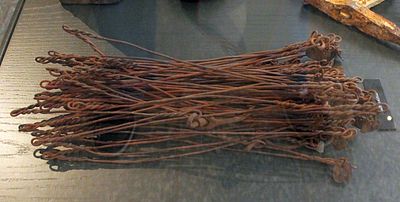Laughing chain
The laugh chain is a measuring chain . It belonged to the historical tools ( hanging tools ) of the Markscheider . The division took place in laughs or "balls", later meters.
history
In the 17th century, measuring cords were mainly used as length measuring instruments. According to Nikolaus Voigtel , the Markscheider used "a twisted cord of 100 laughs, a basted cord of 6 laughs, with details of the laugh marks, whole and half as well as a scale of half a laugh, which is divided into 50 inches or first after the decimal."
The laughing chain came into use in the 18th century because the “basted” or flax cords were too imprecise, especially because their length changed significantly in the mostly humid pit climate. At that time the laugh chain was usually 6 laughers long and consisted of "... weak messy links by means of rings attached to each other"
After the widespread introduction of the metric system, the name measuring chain became established instead of laugh chain .
Laughing chains with rigid links increasingly fell out of use or were only used by Steigern for measurements of low accuracy. At the end of the 19th century, a measuring chain was made of spun brass and later phosphor bronze wire. It was 20 m long and the individual wire segments were connected to one another by rings and swirls at a distance of one meter. The decimal vertebra was given a special shape to make it easier to distinguish; the vertebrae were marked with the respective number of meters. Hooks for hanging are attached to both ends of the chain.
Steel measuring tapes were already in use at the beginning of the 20th century and measuring chains were only used for "subordinate purposes".
literature
- Carl Maximilian Bauernfeind: Elements of surveying . The measuring instruments & their use. Literary and artistic establishment of the JG Cotta'schen Buchhandlung, Munich 1856, p. 322, 329 f . ( Google Books ).
Individual evidence
- ^ Nikolaus Voigtel: Geometry subterranea or Marckscheide art . it teaches how in mines all crevices and passages should be brought into the ground and during the day / even such should be distinguished from one another; as well as what with breakthroughs in saving costs / bringing weather and behavior of water to mines or buildings / with watching; Item / Like disputes / so often wont to appropriate each other among constricting trades / set apart according to measure; Sambt also contains other things contained in the following Indice and useful to this art; All mine lovers for lessons and insurance benefits. 1st edition. Dietzel, Eisleben 1686, On the Use and Fabrication of Their Instruments so Part of the Markscheiden, p. 21 ( Digitalisat SLUB - quoted from Karl Neubert, Walther Stein: Plan- und Rißkunde. 1. Lehrbrief, in: Lehrbriefe für das Fernstudium, Bergakademie Freiberg (ed.), Deutscher Verlag der Wissenschaften, Berlin Jan. 1954, p. 11) .
- ↑ Johann Friedrich Lempe : Thorough instructions for the art of Markscheidekunst . Siegfried Leberecht Grusius, Leipzig 1782, p. 23 ff .
- ^ Ludger Mintrop : Markscheidekunde . Introduction to the, with special consideration of coal mining. 2nd improved edition. Springer, Berlin 1916, p. 36, 37 .
- ↑ Peter Uhlich: Textbook of the Markscheidekunde . Graz & Gerlach (Joh. Stettner), Freiberg 1901, III. Measuring straight lines, p. 86 (402 pp.).

